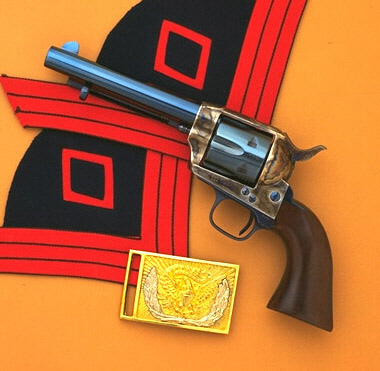Posts: 301 Location: Brisbane, Australia
Fri 17 Nov, 2006 10:46 pm
Rare Photo of Original Armour Bluing
I am only posting this shot because its the only one I have seen like it. After the Victorians finished scrubbing all the original finishes off harnesses and making them nice and shiny for the public to see, occasionally people find a hint of the original bluing ( or browning, etc ) like in this rare photo. Some of you would have seen it before...it might be already here somewhere........but for those who havent seen it.......it must have looked quite dazzeling to see the whole (Anime) "Peacock-Blue" breastplate when new !!
Here's the link also..............
http://www.masterarmourer.com/anime_breastplate.htm
 Attachment: 78.24 KB
Attachment: 78.24 KB
[ Download ]
Posts: 2,121 Location: Northern Utah
Fri 17 Nov, 2006 11:40 pm
A few years back alot of the armour I made I began to either blue or black. it does looks nice. We had a bright suit that was identical to a black one I worked on from teh 1610's. Same in every respect but color. I assume that the one had its paint stripped. Interesting though.
That would be a nice color on the piece for sure.
RPM
Posts: 250 Location: Irvine Spectrum, CA
Sat 18 Nov, 2006 12:17 am
The original blueing looks even more majestic than the new version, in my opinion. What a sight the original, as new, must have been...
Posts: 301 Location: Brisbane, Australia
Sat 18 Nov, 2006 12:21 am
bluing
Indeed........anyone know how it was done ? I believe a formula was used in the quench ? Might be completely wrong here though ? Anyone doing this today ?
Posts: 2
Sat 18 Nov, 2006 11:03 am
Well, some people at my University are experimenting with making a coloured finish while forging, it looks quite amazing. Maybe these guys (Material Scientists) can give you some advice. I think asking somewhere around here
http://www.uni-jena.de/Institut_f%C3%BCr_Mate...logie.html may help. I only saw it on a presentation Wall in their main building, but i could go there to get an email adress if someone is interested .
mfg Richard Knipper
Student at Universitšt Jena , Germany
Posts: 496 Location: Hanover, PA
Sat 18 Nov, 2006 1:24 pm
The color reminds me of this. It's a Cimarron Firearms U.S.V Artilery Model 1898 Single Action Army clone. I have one and the finish is a deep peacock blue except where it has wear from the holster and my fingers. There it has "discolored" to a bronze color.
 Attachment: 65.31 KB
Attachment: 65.31 KB

Posts: 551 Location: flagstaff,arizona
Sat 18 Nov, 2006 3:01 pm
It's hard to judge from pictures on a computer because monitors and other things will vary somewhat, but you can get a color a lot like this just by heating steel to approx. 600 deg. F. Different colors of oxidation appear on the surface of the steel as a result of heat. The violet color that you can see at the edge of the blue occurs at a slightly lower temp.
At red heat a heavier scale begins to form that is bluish-black.
Good temp. control can produce some interesting colors.
Posts: 250 Location: Irvine Spectrum, CA
Sat 18 Nov, 2006 7:09 pm
Here is some info I got from Wikipedia, but edited heavily...
Some prefer to call thin coatings of magnetite (black oxide) by the name bluing, and heavier coatings by the name black oxide. But they are both the same chemical conversion process for providing true steel bluing.
Historically, this process was referred to as browning, as many of the original finishes were brown rather than the newer and safer-to-apply blue coatings that became popular at a later period. Many of the browning and early bluing formulas were based on cyanide containing solutions, which were especially toxic. The terms bluing and browning are interchangeable.
Bluing may be applied by immersing the steel parts in a solution of potassium nitrate, sodium nitrate, and water heated to the boiling point. Similarly, stainless steel parts are immersed in a mixture of nitrates and chromates. Either of these two methods, among others also, is called hot bluing. Hot bluing is among the most effective forms of bluing, providing the most permanent degree of cosmetic protection. It must be additionally oiled to provide any significant rust resistance.
Large-scale industrial bluing is also performed using a bluing furnace. This is an alternative method for creating the magnetite (black oxide) coating. It is possible to heat steel precisely in a controlled environment, such as to cause the formation of black oxide selectively over the red oxide. It, too, must be additionally oiled to provide any significant rust resistance.
You
cannot post new topics in this forum
You
cannot reply to topics in this forum
You
cannot edit your posts in this forum
You
cannot delete your posts in this forum
You
cannot vote in polls in this forum
You
cannot attach files in this forum
You
can download files in this forum
